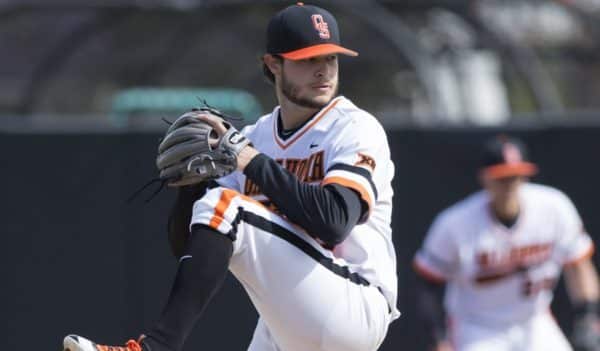
Cubs Top Pick Tom Hatch Throws Complete Game Shutout to Open College World Series
The College World Series is a pressure packed event. On Saturday afternoon, I had the time to watch the Cubs’ third round pick, pitcher Tom Hatch from Oklahoma State, go up against UCSB in the opening game. Hatch is a right-handed starter who is 6-1 and about 195 pounds. He has a four-pitch repertoire that includes a fastball, slider, changeup, and sinker, and is known more for pitching to ground ball contact than for getting strikeouts.
When working from the windup, Hatch stands straight with his hands at his waist and throws from a three-quarter arm slot. When he goes to the stretch, he gets in this little Virginia-type crouch that I think takes away some of his command and velocity. I saw him several times come in on the hands of right-handed hitters to jam them up. I also like the fact that Hatch is not afraid to move the ball around the zone.
Hatch seemed a little nervous or just a bit off in the 1st as he walked a better, but he was still able to induce three groundouts. Every pitch he threw was down in the zone and moving, though, which explains why hitters pounded the ball into the turf.
Hatch relaxed in the 2nd, striking out the first batter before leaving a ball up in the zone that was hammered into left center for a double. He got the third hitter to line out before a single put men on first and third. Hatch then got out of the inning with a strikeout. He got through the 3rd inning after allowing a hit, but he started changing how he was using his pitches in the 4th.
By this point, Hatch looked more in control of his arsenal, which meant throwing a changeup more regularly. I really like that he has four pitches that he can throw between 79 and 92 miles an hour. That has to keep the hitter guessing. I also became very intrigued by his ability to throw the sinker down and in to left-handed hitters. He would start the pitch almost at the hitter’s back knee and the ball would break back over the plate. I thought that was a really good way to use the break on the pitch.
Entering the 5h inning, Hatch had thrown 61 pitches, 35 for strikes. Throughout the inning he looked completely in command, striking out two, the last of which came from going in on the hands again. I like a pitcher who is not afraid to pitch inside.
As Hatch got into the 6th inning, you could start to see the frustration settling in for the UCSB hitters. He had such good command of his pitches that he was getting ahead early and then forcing the opposition to swing at pitches that he wanted them to swing at. After six innings he’d thrown 83 pitches, 51 for strikes. He was getting better as the game went on.
 As such, he induced a pair of pop-ups and only needed 10 pitches to get through the 7th. At that point, he was at 93 pitches with 58 strikes and had set down 11 straight batters. It seemed that his slider got more movement as the game went gone on, and I also liked that he was throwing his changeup more and more to keep hitters off balance.
As such, he induced a pair of pop-ups and only needed 10 pitches to get through the 7th. At that point, he was at 93 pitches with 58 strikes and had set down 11 straight batters. It seemed that his slider got more movement as the game went gone on, and I also liked that he was throwing his changeup more and more to keep hitters off balance.
It is very hard to go through a lineup three times and still dominate the each time. But the end of 8 innings, Hatch had struck out six and allowed four hits. At 102 pitches, I began to wonder if the Cowboys were going to send him out in the 9th to finish the game. Being that this was a college game, though, I had pretty much convinced myself that Hatch would be given the chance to finish the game. Considering there was no one up in the bullpen, it didn’t take a genius to figure that out.
The 9th inning was more the same. Hatch got two ground outs, gave up a single, and struck UCSB’s best hitter out to end the game and finish off the shutout. I came away extremely impressed with the physical aspects of Hatch’s approach, and also how he used his pitches to set hitters up. It was a masterful complete-game performance.
So where does he fit in the Cubs’ system?
Compared to other Cubs prospects, I think Hatch should fit easily in the top 20, maybe even top 15 just based on his command of those top three pitches. As far as how he compares to other pitchers in the system, I think he’s going to be a little bit below Dylan Cease and Duane Underwood. He’s perhaps a little bit better in terms of command of his pitches than most of his peers in the organization.
I would probably put him somewhere in my top 15, either right at where Trevor Clifton is or a little bit higher in terms of pitchability. When he gets to throwing full-time next year, he easily could be the third best starting pitcher in the system. The best thing in all this is that the Cubs have not even begun to develop him yet. I think he might be a number three starter and it’s not gonna take him long to get here based upon what I saw on Saturday.

